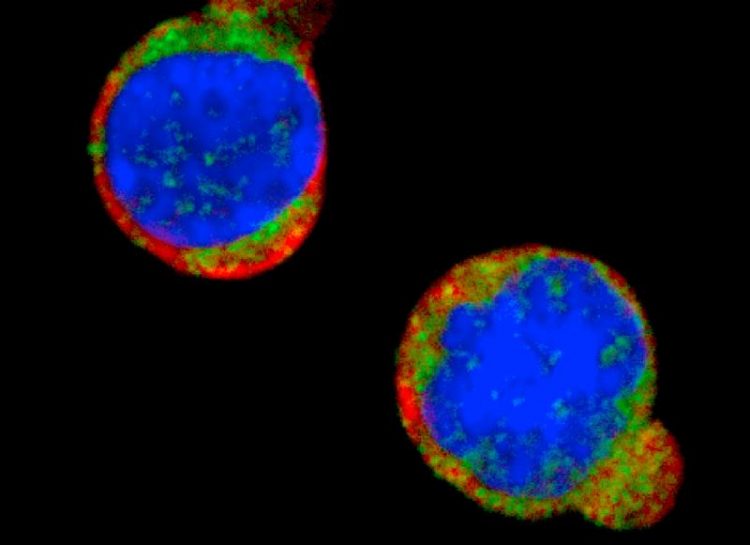Virus infections of bone marrow donors influence the outcome of transplantations

Long-term stem cell under the confocal microscope, stained with specific fluorescent antibodies. Simon Renders, HI-STEM / DKFZ
In brief: The health of the donor is just as important as that of the recipient for the success of a bone marrow transplantation. „However, our study does not focus on the impeccable health of the donor at the time of the bone marrow donation – since this is a pre-requisite and thoroughly checked for“, states Dr. Christoph Hirche, a former scientist at the Institute of Experimental Infection Research at TWINCORE – now at the Heidelberg Institute for Stem Cell Technology and Experimental Medicine (HI-STEM).
„We have investigated the long-term effects of past, subsided virus infections on bone marrow stem cells.“ Specific focus was laid on the least differentiated and most long-lived stem cells, so-called „long-term stem cells“. These cells are resting under normal conditions, divide rarely and therefore represent a ‚backup’ of the blood-generating system. They are only activated in highly critical situations, where they produce an increased amount of differentiated cells to help counteract life-threatening bottlenecks of the blood and immune system.
One of the emergency situations when these stem cells become activated is strong systemic inflammation. During this process, type I interferon is produced and wakes the resting stem cells. „Type I interferon is especially important as a first line of defense against virus infections. This is why we set out to investigate the type I interferon-dependent activation of stem cells upon different virus infections“, states Dr. Theresa Frenz of the Institute of Experimental Infection Research at TWINCORE. „Due to it’s high relevance during clinical transplantations, Cytomegalovirus infection was of special interest.“
The scientists could show that not every virus infection that elicits a release of type I interferon automatically activates the resting bone marrow stem cells – but when it happens, it has substantial impact on the transplantation success: When transplanting stem cells which were activated by a Cytomegalovirus infection „we observe that these stem cells do their job much less efficiently – they don’t differentiate as balanced and reliably as they should“, states Dr. Christoph Hirche.
„Truely striking, however, is the observation that bone marrow cells continue to show functional deficits for weeks after the acute infection. Even though these stem cells look as if they have completely ‚recovered’, they replenish the blood and immune system less efficiently and show an altered differentiation profile.“ An effect that made sense once the scientists not only looked at complete bone marrow populations, but also at single stem cells: These cells retained signs of an inflammation on a genetic level for weeks.
How strong does a virus infection in humans need to be to wake long-term stem cells from their resting state and to long-lastingly influence them after the acute phase of infection? This remains an open question. „But what we do know is that, in the future, the infection background of potential stem cell donors needs to be investigated more carefully“, emphasizes Prof. Ulrich Kalinke, head of the Institute of Experimental Infection Research. „The success, or failure, of a bone marrow transplantation is obviously also dependent on the infection record of the donor, not just the current health status of the recipient. These are important revelations for clinical transplantation medicine.“
http://www.twincore.de/en/infothek-and-press/infothek-news-single/news/virus-inf…
Media Contact
All latest news from the category: Life Sciences and Chemistry
Articles and reports from the Life Sciences and chemistry area deal with applied and basic research into modern biology, chemistry and human medicine.
Valuable information can be found on a range of life sciences fields including bacteriology, biochemistry, bionics, bioinformatics, biophysics, biotechnology, genetics, geobotany, human biology, marine biology, microbiology, molecular biology, cellular biology, zoology, bioinorganic chemistry, microchemistry and environmental chemistry.
Newest articles

Bringing bio-inspired robots to life
Nebraska researcher Eric Markvicka gets NSF CAREER Award to pursue manufacture of novel materials for soft robotics and stretchable electronics. Engineers are increasingly eager to develop robots that mimic the…

Bella moths use poison to attract mates
Scientists are closer to finding out how. Pyrrolizidine alkaloids are as bitter and toxic as they are hard to pronounce. They’re produced by several different types of plants and are…

AI tool creates ‘synthetic’ images of cells
…for enhanced microscopy analysis. Observing individual cells through microscopes can reveal a range of important cell biological phenomena that frequently play a role in human diseases, but the process of…





















